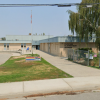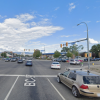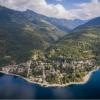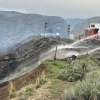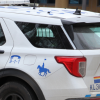Graffiti: is it a criminal activity, or is it art that can actually explore further into B.C.’s more controversial issues?
God Save the Underworld is a new exhibit at Kelowna’s Alternator Gallery, and its focus isn’t exactly mainstream. The exhibit is composed of street art that touches on several hot button issues, including the criminalization of graffiti as vandalism, missing Indigenous women, and the waste dumped into B.C.’s waterways.
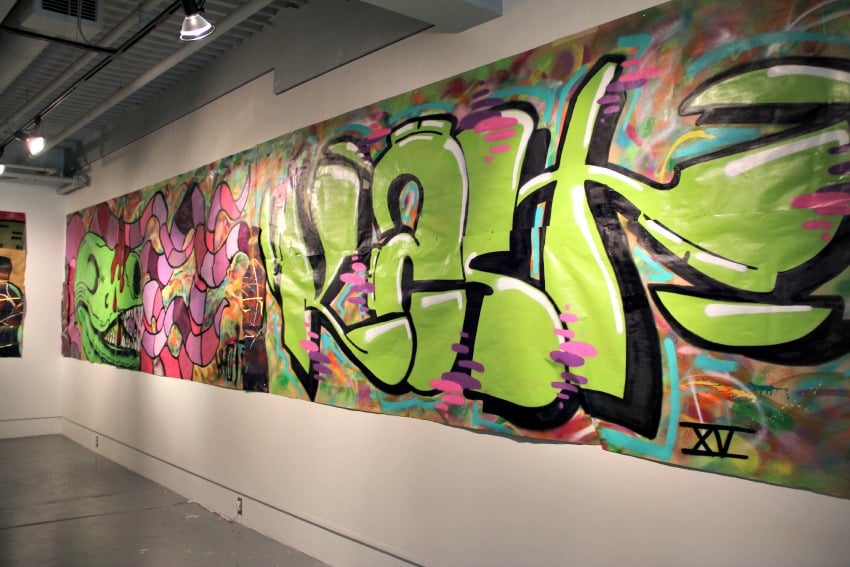 One of the pieces at the Alternator Gallery. (Photo Credit: KelownaNow.com)
One of the pieces at the Alternator Gallery. (Photo Credit: KelownaNow.com)
Chris Bose is the artist heading up the exhibit, which also features work from other members of the Kamloops’ Arbour Collective, an urban Aboriginal, Métis, and Inuit artist association.
Bose, who’s from the N’laka’pamux and Secwepemc Nations here in the Interior, talked about street art and how it’s seen as a criminal activity rather than art. In Kamloops, Bose says there’s no public street art wall and therefore no legal output for what they create. “Instead, everything’s hidden, everything’s really challenged,” said Bose. Without a legal place for their art, he says that instead artists find abandoned buildings, they paint under bridges, and they discover things that are long forgotten.

Exhibit D shows graffiti created over rock drawings, demonstrating the layered and ephemeral nature of street art. (Photo Credit: KelownaNow.com)
“If you get caught doing that, even if it’s an abandoned space, it’s a $2500 fine,” said Bose. “They confiscate all your materials. They take everything. And then you get a minimum of 100 hours of community service.”
“It’s criminalizing creativity. It’s criminalizing an art form.”
God Save the Underworld portrays this idea, putting the artwork itself up on trial as different exhibits for a prosecution. Exhibit A nails up a bag of spray can lids as if they were a bag of cocaine, while Exhibit C shows an actual metal installation piece that would be glued to old bridges.
“If we try to push it under and criminialize it and don’t give it a creative outlet, people are going to find a way and a place to do it,” explained Bose. He said that the show is meant to show people that an entire art movement is going on around them that they’re not even aware of. “It’s so shoved underground that artists risk life and limb to go paint on a wall,” said Bose.
“There’s tagging, and then there’s street art. Tagging is vandalism. Street art is an art form that’s not yet socially accepted in most of the Western world.”
 Two pieces of "evidence": spray can lids bagged up like drugs and an installation piece that would be glued to abandoned structures. (Photo Credit: KelownaNow.com)
Two pieces of "evidence": spray can lids bagged up like drugs and an installation piece that would be glued to abandoned structures. (Photo Credit: KelownaNow.com)
The artwork isn’t just centered on graffiti, however. Bose also challenges the issue of Canada’s missing and murdered Indigenous women. He has four silhouettes of women throughout the exhibit, meant to represent four women who have gone missing in Kamloops since January. The women have a sheen of glitter, showing how people tend to gloss over such tragedies and forget about them.
Other controversial issues include the waste dumped into the South Thompson river, the Mount Polley mine spill, and the greed of industry. “We’re so blinded by industry, greed, that we don’t pause,” said Bose. “We don’t think about it.” In September 2014, the City of Kamloops accidently emptied the equivalent of two Olympic-sized swimming pools worth of sewage into a creek and subsequently the Thompson River. “It goes through the fish. It goes through the environment. Aboriginal people, we eat a lot of fish up here. It’s going to start affecting us.”
His mural also references the pulp mill, and he criticized officials for not charging the company for any air pollution. “That’s called industry. That’s not pollution. It’s how we phrase things, how we justify things to let something continue.”
This justifying and glossing over are key to Bose's message, and the art subsequently rejects attempts to just walk on by. Several pieces could be seen as disturbing, thanks to industry itself being portrayed as horrific, hungry mouths. Several disfigured faces add shock value and even create a visceral reaction to associate with the industry, pollution, and consumer values they are meant to represent.
Since street art and graffiti themselves are so challenged, the exhibit becomes that much more powerful by using these techniques to challenge the way people ignore important issues around them.
 Bose portrays the South Thompson River with waste being poured in. (Photo Credit: KelownaNow.com)
Bose portrays the South Thompson River with waste being poured in. (Photo Credit: KelownaNow.com)
The artwork on display is being called controversial, and Bose explained why the installation and street art in general would be termed so. “It’s controversial because people don’t understand it, and what they don’t understand, they fear.”
The God Save the Underworld exhibit opens at the Alternator Centre in the Rotary Centre for the Arts on Friday, May 29th with an opening reception at 7 p.m. The evening will include an artist talk by Bose.








